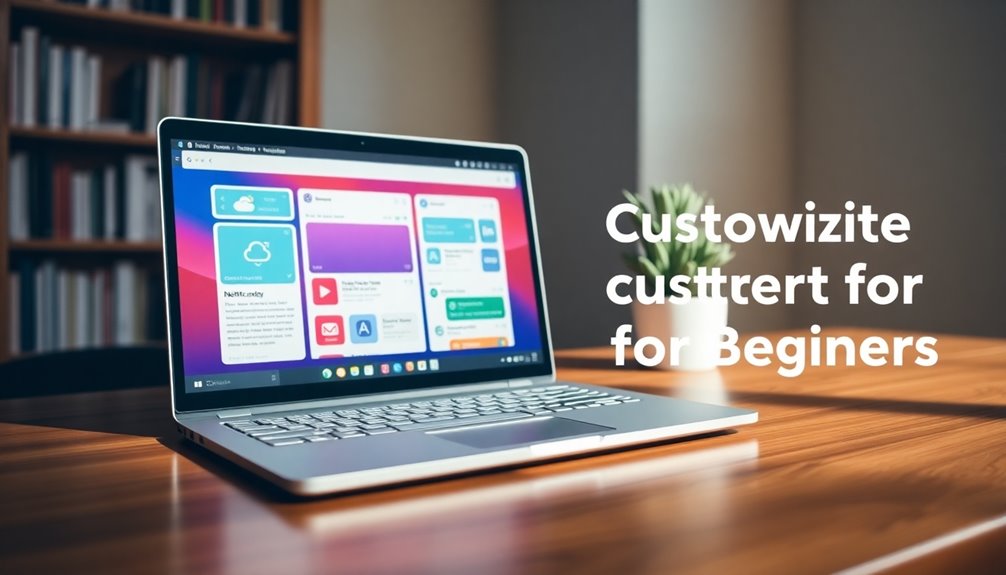A widget on a website is a small, customizable tool that enhances functionality and improves user experience. You can think of them as interactive elements that display real-time data, social media feeds, or even forms. They operate independently from your main content and are easy to add with drag-and-drop features. Various types exist, like social media or chat widgets, each serving different purposes. Widgets are also user-friendly, making them perfect for non-tech users. If you're curious about how to create or customize widgets for your site, there's plenty more to discover!
Definition of Website Widgets
A website widget is a small, customizable application that you can embed into your site to enhance its functionality.
These widgets operate independently from your main website content, allowing you to provide quick access to specific features or information that can greatly improve user experience. By integrating widgets, you can display real-time data, social media feeds, and interactive forms, making your site more dynamic and engaging. Additionally, using analytics tracking plugins can help you monitor how users interact with these widgets. Widgets can also be customized to include specific content types, tailoring the information presented to meet the needs of your audience.
Creating website widgets typically involves using web technologies like HTML, CSS, and JavaScript, which allows for easy integration into various areas of your site, such as sidebars and footers. Common examples include chat boxes for customer support, weather updates, social media sharing buttons, and email subscription forms.
Incorporating these customizable applications into your site boosts user engagement by enabling visitors to interact with features without straying away. This increases the time they spend on your site and helps reduce bounce rates. Additionally, selecting the right widget functionality can significantly enhance user engagement and overall site performance.
How Widgets Work
Website widgets enhance functionality by seamlessly integrating small applications into your site. These widgets utilize web technologies like JavaScript, HTML, and CSS, allowing you to enhance user experience without needing extensive coding knowledge. They pull data from external sources through web APIs, enabling you to display real-time information, such as weather updates or social media feeds, right on your webpage. Additionally, widgets can benefit from using custom post types to organize and display dynamic content more effectively. Widgets can also be designed to integrate with responsive themes that ensure they look great on any device.
You can easily integrate widgets into various areas of your site, including sidebars, footers, or headers. This flexibility means they can operate independently from your main website content, ensuring that critical information is always visible to users.
Most widgets are also customizable, letting you modify design elements like colors and layouts to align with your branding while keeping user-friendly interfaces.
Moreover, their compatibility with multiple web environments guarantees that widgets function seamlessly across different browsers and devices. This enhances accessibility and boosts user engagement, making it easier for visitors to interact with your content. Additionally, widgets can incorporate dynamic multimedia elements to further enrich the user experience by engaging visitors with captivating visual and interactive content.
Types of Widgets

Numerous types of widgets can greatly enhance your website's functionality and user experience. For instance, social media widgets allow users to share your content and follow your brand directly, boosting engagement and visibility across platforms. With around 4.9 billion global social media users, leveraging these widgets can markedly enhance your online presence.
E-commerce widgets streamline the online shopping experience. They display products, manage shopping carts, and facilitate seamless checkouts, making it easier for customers to make purchases without leaving your site. Additionally, utilizing SEO plugins can further improve the effectiveness of these widgets by optimizing their performance on search engines.
Chat widgets are essential for real-time communication, enabling instant assistance between your business and visitors. This not only improves customer support but can also lead to higher conversion rates.
Email marketing widgets help you collect leads by integrating forms for newsletter subscriptions and user-generated content. This enhances your email marketing strategy with dynamic content tailored to your audience.
Lastly, analytics widgets provide valuable insights into user behavior and website performance metrics. By understanding these metrics, you can make informed decisions to optimize your site, ultimately improving user experience and enhancing functionality. Additionally, incorporating plugins can significantly enhance your site's security and performance, protecting both your business and your customers.
Widgets vs. Plugins
When you're managing a website, it's important to understand the differences between widgets and plugins. Widgets offer specific functionalities and are easy to add without much tech knowledge, while plugins extend your site's capabilities and often require more complex installation. Knowing when to use each can greatly enhance your site's performance and user experience. Additionally, using security plugins can help safeguard your website while you explore and implement various widgets and plugins. It's essential to ensure that your website is protected against potential threats, such as malicious attacks, to maintain its integrity and trustworthiness.
Functionality Differences Explained
Understanding the differences between widgets and plugins is essential for anyone looking to optimize their website's functionality.
Widgets are small, customizable tools that enhance specific areas of your site, making them ideal for content display and interactive elements like social media feeds or contact forms. They offer easy integration, allowing you to add or remove them without needing extensive technical knowledge.
On the other hand, plugins provide broader functionality that can greatly alter your entire site's capabilities. They often include multiple features in one package, like SEO optimization or security enhancements, which can enhance user experience but may require installation and more complex management.
While widgets focus on specific areas, plugins often serve as an extensive solution for website management.
Importantly, widgets can be integrated into plugins, providing designated features in particular sections of your site. This complementary relationship means you can leverage both tools effectively.
Understanding these distinctions helps you choose the right tools to meet your specific needs, ultimately creating a more engaging and efficient website for your visitors.
Installation Process Comparison
The installation process for widgets and plugins highlights their different user experiences.
Widgets are designed with user-friendly interfaces, making them accessible even for non-technical users. You can easily add widgets by copying and pasting a simple HTML/JavaScript code snippet directly into your website. Many content management systems (CMS) even offer drag-and-drop functionality, allowing you to customize and place widgets effortlessly.
In contrast, installing plugins often requires a more complex process. You typically need to download the plugin, upload it to your CMS, and then activate it through an admin panel. This process may necessitate some technical knowledge to guarantee everything is set up correctly. While plugins can offer powerful features, the installation process can feel cumbersome compared to widgets.
Another key difference lies in updates. Widgets can often be updated independently via their respective platforms, keeping your website running smoothly.
On the other hand, plugins might require periodic updates from the CMS or the plugin developer, which can affect compatibility and security.
Ultimately, choosing between widgets and plugins often depends on your comfort level with technology and your specific website needs.
Usage Scenarios for Each
Choosing between widgets and plugins often hinges on the specific needs of your website. While both can improve your website, they serve different purposes and scenarios.
- User Interaction: If you want to enhance user experience through interactive elements, widgets are your go-to. For instance, a social media widget can engage visitors without redirecting away from your content.
- Quick Access to Information: Widgets provide easy access to features like customer support chat or email subscriptions. This independent functionality helps keep users engaged while they browse.
- Enhanced Functionality: On the other hand, if you need to enhance functionality across your site—like adding SEO tools or e-commerce capabilities—plugins are more suitable.
They integrate deeply into your site's backend, allowing for more complex features.
Benefits of Using Widgets

Using widgets on your website can considerably enhance user engagement by adding interactive features that keep visitors interested and reduce bounce rates.
These cost-effective solutions provide real-time updates and opportunities for social sharing, making it easier for you to connect with your audience.
Plus, with customizable options, you can tailor widgets to reflect your brand and meet your specific needs.
Enhanced User Engagement
Widgets can transform your website into a more engaging platform, actively drawing users in with interactive features. By incorporating these elements, you can greatly boost user engagement and keep visitors coming back.
Here are three key benefits of using widgets:
- Real-Time Updates: Widgets provide live information, like weather forecasts or news feeds, keeping your audience informed and interested. This feature enhances website stickiness, encouraging users to spend more time on your site.
- Social Media Sharing: Integrating social media widgets allows visitors to easily share content and interact with your posts. With over 4.9 billion social media users, this can dramatically increase your reach and engagement.
- Lead Capture: Implementing lead capture widgets effectively collects visitor information, enabling ongoing communication. This nurtures relationships that lead to increased conversions and customer loyalty, reducing bounce rates.
Cost-Effective Interactivity Solutions
Enhancing user engagement through interactive features doesn't have to break the bank. Widgets offer a cost-effective solution for adding interactivity to your website. Often available for free or at low subscription costs, they provide essential functionality like chat support and social media sharing, which can greatly boost user engagement. This increase in interaction can lead to higher conversion rates and reduced bounce rates.
Moreover, widgets allow you to gather valuable analytics on user behavior and preferences without the hefty price tag of custom applications. This data enables you to refine your marketing strategies, tailoring them to your audience's needs.
The beauty of widgets is their quick implementation and easy customization, making them accessible even for small businesses and startups with limited budgets.
With many widgets featuring built-in analytics, you can track performance and user interactions, giving you insights that drive further improvements. By leveraging these cost-effective interactivity solutions, you not only enhance your website's functionality but also create a more engaging experience for your visitors, ultimately contributing to your business's growth and success.
Best Practices for Widgets
When it comes to effective web design, best practices for incorporating widgets can make a significant difference in user experience. By following these guidelines, you'll enhance functionality and engage visitors more effectively:
- Be Mobile-Friendly: Confirm your widgets are responsive. With over 50% of web traffic coming from mobile devices, adapting your widgets for smaller screens is essential for maintaining user engagement.
- Regular Updates: Always update widgets to keep them secure and functional. Outdated widgets may expose your site to vulnerabilities and performance issues, negatively impacting the user experience.
- Monitor Performance: Utilize analytics to track how your widgets perform. Monitoring allows you to optimize user engagement, reduce bounce rates, and increase the time users spend on your site.
Additionally, limit the number of widgets on a page to prevent clutter and maintain a clean user interface.
Security and Privacy Concerns

With the increasing reliance on third-party widgets, security and privacy concerns have become essential. These widgets can introduce significant security vulnerabilities if not properly vetted, potentially executing malicious scripts that expose sensitive user data to third-party services. A prime example is the Facebook Secret Crush widget, which was linked to adware installation, highlighting how poorly designed widgets can compromise user privacy and device security.
You should always be cautious of widgets that request excessive permissions. Such permissions can lead to misuse of access to your personal information and browsing habits.
Furthermore, host websites often lack control over content delivered by these widgets, making it tough to mitigate potential security risks or remove harmful content once embedded.
To protect yourself, it's vital to regularly monitor and update widget software. This practice helps address any security flaws and guarantees compliance with privacy regulations, safeguarding your user data.
SEO Implications of Widgets
Widgets can play a significant role in your website's SEO strategy, but they come with potential pitfalls that you need to navigate carefully. If not managed well, widgets can generate unindexed links that search engines may overlook, affecting your site visibility.
Here are three key SEO implications of using widgets:
- Crawl Issues: Widgets that manipulate links can cause search engines to struggle with indexing your content properly, leading to potential penalties.
- Diluted SEO Value: If your widgets pull in external content that doesn't align with your site's primary keywords, they may dilute your page's overall SEO value.
- Optimization Needs: To maximize performance, you need to optimize widget content. This includes using proper alt tags and incorporating relevant keywords.
Regularly auditing the widgets on your website is essential. By ensuring they don't hinder search engine rankings or create crawl issues, you can maintain a strong SEO presence.
Accessibility Considerations

Ensuring accessibility in web widgets is essential for creating an inclusive user experience. By focusing on accessibility, you enhance usability for all users, including those with disabilities.
Implementing WAI-ARIA technology is a key step in this process, as it provides additional semantics that help screen readers recognize the function of your widgets. When designing widgets, make sure to include specific roles like tablist, tab, and tabpanel. This enables proper navigation for assistive technologies.
Compliance with keyboard navigation standards is also important; it allows users to interact with widgets without relying solely on a mouse, which is critical for those who use keyboards or other input devices.
Following accessibility guidelines such as WCAG can greatly improve user experience by ensuring that your web widgets are usable by individuals with diverse needs.
Prioritizing accessibility not only meets legal requirements but also demonstrates your commitment to an inclusive digital environment. By taking these considerations into account, you can create web widgets that everyone can enjoy and utilize effectively, making your website more welcoming and functional for all.
Customizing and Creating Widgets
Often, customizing and creating widgets can be a rewarding experience that enhances your website's functionality and aesthetics.
Whether you're a coding pro or just starting, you can tailor custom widgets to fit your needs. Here's how to get started:
1. Choose Your Approach: If you have coding knowledge in HTML, CSS, and JavaScript, you can create widgets from scratch.
Otherwise, platforms like Common Ninja and FormLoop provide user-friendly interfaces for easy customization without extensive coding skills.
2. Align with Branding: Make certain your custom widgets reflect your overall branding.
Use consistent colors, fonts, and logos to create a cohesive look that resonates with your audience.
3. Test for Functionality: After creating your widget, it's essential to test it across various devices and screen sizes.
This guarantees peak functionality and a smooth user experience on both desktop and mobile platforms.
Conclusion
Now that you've uncovered the essentials of website widgets, you might be wondering how they can transform your site. Imagine enhancing user experience, increasing engagement, and even boosting your SEO—all with the right widgets. But remember, not all widgets are created equal; some may come with hidden risks. Are you ready to explore the world of customization and create widgets that truly resonate with your audience? The next step could change everything for your website.



